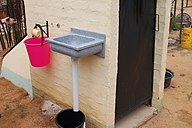WASH (or Watsan, WaSH; stemming from the first letters of "water, sanitation and hygiene") is a sector in development cooperation or within local governments that provides water, sanitation, and hygiene services to people. The main purposes of providing access to WASH services include achieving public health gains, implementing the human right to water and sanitation, reducing the burden of collecting drinking water for women, and improving education and health outcomes at schools and health facilities. Access to WASH services is also an important component of water security.[1] Universal, affordable, and sustainable access to WASH is a key issue within international development and is the focus of the first two targets of Sustainable Development Goal 6 (SDG 6).[2] Targets 6.1 and 6.2 aim for equitable and accessible water and sanitation for all. In 2017, it was estimated that 2.3 billion people live without basic sanitation facilities, and 844 million people live without access to safe and clean drinking water.[3] The acronym WASH is used widely by non-governmental organizations and aid agencies in developing countries.
The WASH-attributable burden of disease and injuries has been studied in depth. Typical diseases and conditions associated with a lack of WASH include diarrhea, malnutrition, and stunting, in addition to neglected tropical diseases.[citation needed] Lack of WASH poses additional health risks for women, for example, during pregnancy or in connection with menstrual hygiene management[citation needed]. Chronic diarrhea can have long-term negative effects on children in terms of both physical and cognitive development.[4] Still, collecting precise scientific evidence regarding health outcomes that result from improved access to WASH is difficult due to a range of complicating factors. Scholars suggest a need for longer-term studies of technology efficacy, greater analysis of sanitation interventions, and studies of the combined effects of multiple interventions to better analyze WASH health outcomes.[5]
Access to WASH needs to be provided at the household level but also in non-household settings like schools, healthcare facilities, workplaces (including prisons), temporary use settings, and for dislocated populations.[6] In schools, group handwashing facilities can improve hygiene. Lack of WASH facilities at schools often prevents female students from attending school, thus reducing their educational achievements.[7]
It is difficult to provide safely managed WASH services in urban slums. WASH systems can also fail quite soon after installation (e.g., leaking water distribution systems). Further challenges include polluted water sources and the impacts of climate change on water security. Planning approaches for more reliable and equitable access to WASH include, for example, national WASH plans and monitoring, women's empowerment,[8] and improving the climate resilience of WASH services. Adaptive capacity in water management systems can help to absorb some of the impacts of climate-related events and increase climate resilience.[1]: 25 Stakeholders at various scales, i.e., from small urban utilities to national governments, need to have access to reliable information about the regional climate and any expected changes due to climate change.
- ^ a b "REACH Global Strategy 2020-2024". REACH program. Oxford, UK: University of Oxford. 2020.
- ^ "Goal 6 .:. Sustainable Development Knowledge Platform". sustainabledevelopment.un.org. Retrieved 2017-11-17.
- ^ Progress on drinking water, sanitation and hygiene: 2017 update and SDG baselines. Geneva: WHO, UNICEF. 2017. ISBN 978-9241512893. OCLC 1010983346.
- ^ "Water, Sanitation & Hygiene: Strategy Overview". Bill & Melinda Gates Foundation. Retrieved 27 April 2015.
- ^ Waddington H, Snilstveit B, White H, Fewtrell L (2012). "Water, sanitation and hygiene interventions to combat childhood diarrhoea in developing countries". Journal of Development Effectiveness. doi:10.23846/sr0017.
- ^ Cite error: The named reference
:21was invoked but never defined (see the help page). - ^ "Water, Sanitation, and Hygiene: Introduction". UNICEF. Retrieved 27 April 2015.
- ^ Dery, Florence; Bisung, Elijah; Dickin, Sarah; Atengdem, Jeremiah (2021). "'They will listen to women who speak but it ends there': examining empowerment in the context of water and sanitation interventions in Ghana". H2Open Journal. 4 (1): 231–243. doi:10.2166/h2oj.2021.100. ISSN 2616-6518.
 Text was copied from this source, which is available under a Creative Commons Attribution 4.0 International License
Text was copied from this source, which is available under a Creative Commons Attribution 4.0 International License



